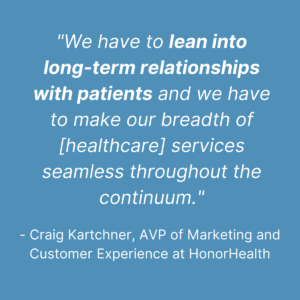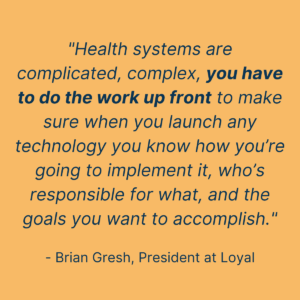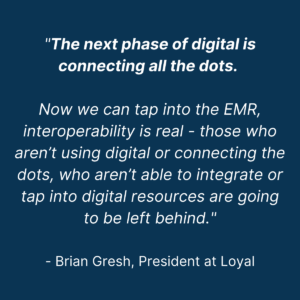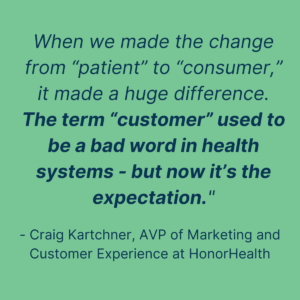
In the health system market, the term “digital transformation” is a hot topic. The use of digital technology to connect with consumers has become part of most (if not all) healthcare system strategies. Driven in part by the pandemic, digital transformation has taken even more of a front seat in health systems. According to IDC Worldwide Healthcare Predictions 2022, By 2023, 70% of healthcare organizations’ attempts to scale value-based care models will fail unless they invest in data-driven governance, operations, and organizational infrastructure.
Recently, the Hileman Group hosted a webinar titled “Navigating Digital Transformation for Health Systems,” co-hosted and moderated by BWG, with Al Zinkand, Director at Baylor Scott & White Health, Brian Gresh, President at Loyal, Craig Kartchner, AVP of Marketing and Customer Experience at HonorHealth, and Tom Hileman, President at Hileman Group, to talk about the successes and challenges they’ve found in navigating digital transformation with their own and/or other health systems – and how they see digital transformation moving forward. Perspectives ranged from health system executive to health system marketer to digital health platform vendor to digital marketing agency executive.
Brian Gresh: There are lots of great digital tools out there but a lot of them don’t talk to one another, so when you talk about digital transformation for health systems today, it’s really all about transforming the patient journey into a singular, connected customer experience.
Tom Hileman: Digital transformation for health systems means an opportunity to rethink the way health systems engage with their patients. Every part of the patient journey should be seamless and patients should have choices between touchpoints and touchless care. We have an opportunity to rethink the customer experience, meeting people where they are, communicating when they are and where they are in the customer journey.
Craig Kartchner: We need to look beyond the term “digital front door,” which is too marketing-centric. We need to make the consumer’s health experience connected so that before they even know they need care until after they leave our doors, that experience is as easy and convenient as possible. We should connect the patient journey and create a seamless experience for caregivers, clinicians, and our ancillary teams.
Brian: What we don’t hear when we get started with a client is the conversation around data. A lot of folks like to jump to the shiny object, the engagement piece right away without thinking about the underlying foundations of how to fuel those interactions. “Getting your house in order,” so to speak, understanding your data, is vital. Data has to be clean and seamless across the organization first.
Who’s in charge of digital transformation in the world we’re living in today? There are so many new players at the table – there are a lot of people who want to participate, beyond the digital and marketing teams, like Chief Medical Officers, Chief Medical Informatics Officer, the Chief Financial Officer, the Director of Strategy – the list goes on. But you need to figure out who’s in charge of digital transformation, because if you don’t know, your patients won’t know.
Tim: We want our customers to be a partner in their own health and their own healthcare journey. Enterprise data – data understanding – means really knowing your customer. Data is the next level of serving our customers.
Craig: How can you know where your customers’ pain points are to address them, where their delight points are to replicate them, if you’re not utilizing data? We do a lot of journey-mapping at HonorHealth to better understand our customers, and we use online panels to help us prioritize where to focus our efforts. One of the big surprises in those panels: Telehealth wasn’t as sexy as we thought it would be. We’d never have known that if we didn’t use the data and ask our customers for their input.
 If you think about what we have in traditional health care vs Amazon and orgs like Village MD, they have the culture to innovate quickly and to use technology in a really brilliant way; but what they don’t have that we need to leverage is the breadth of services and the relationships. We have to lean into long-term relationships with patients and we have to make our breadth of services seamless throughout the continuum.
If you think about what we have in traditional health care vs Amazon and orgs like Village MD, they have the culture to innovate quickly and to use technology in a really brilliant way; but what they don’t have that we need to leverage is the breadth of services and the relationships. We have to lean into long-term relationships with patients and we have to make our breadth of services seamless throughout the continuum.
Brian: Yes. When I hear that healthcare needs to be more like Amazon – I think what they do is easy. They have all the access to data on their customers so it’s pretty easy to determine what they want and when they want it, but healthcare is really different. There’s the relationship aspect, there’s the privacy aspect, and the intimacy of the relationship that happens between clinicians and patients, and the way you have to handle that journey is different. The way you apply those digital tools has to be different than the way an Amazon or a Walmart would apply them, the way you use data has to be different – you can’t just tap into the EMR and use whatever you want, there are a lot of different factors.
Healthcare has to get to the point that they understand their patients as customers, and those customers understand how to use digital tools, and you have to align with that, you can’t just offer an in-person visit or a phone call, you gotta accept that they’re way more savvy than we give them credit for.
Craig: When severity and acuity are low, the customer is focused on convenience, ease, getting in and out fast. When severity is high and acuity is high, that’s when our customers need the breadth of experience and the relationships we offer. But they’re also willing to do the research to find the best experience and the best care, the best relationships – so we have to realize that we have to earn their business every time, and we have to transform to do that.
Yes, we have the breadth of experience and relationships, but we have to make sure we provide that really excellent customer experience, and simplify their process. We’ve got to focus on transparency, transitions of care, seamlessness, and maintaining relationships if we’re going to stand a chance of competing with Amazon.
Tom – Competitively, what they don’t have is specialty care, they have primary care, maybe some ortho or some urgent stuff, but there’s nothing specialized, no oncology or neuro or digestive services, no “breadth of service.” Our job is to make their experience unified and to not make people feel like we’re just passing them along referral to referral, and patient navigation is a key piece of that. If you need anything beyond primary care, deeper levels of specialized care, the relationships and the trust in the breadth of services becomes more important.
Al: Through long journey surveys with customers, we’ve found that choosing to focus on specific problems and concerns that really matter to them improves people’s decisions about which health system to choose. It’s about behavior. We embed personalization on the customer journey, segmenting content they see based on demographics, and we see more conversion, loyalty, and retention.
Tom: Sort through the noise and find out what’s real. There are tons of tools in the space, but begin with the end in mind. People first, to change and help organize, then process, then technology, then the data, those four axes give us a good clear vision. We look for interesting moments – where can we make a difference? What tools will help us achieve our goals and play well with others?

Brian: I agree there are lots of tools out there, and regardless of the tool, you have to have a strategy first, knowing why you’re going to use this tool and what you want the outcome to be. The tools themselves aren’t going to determine the success, it’s going to be the strategy and making sure the right stakeholders are aligned around the strategy, then governance. Health systems are complicated, complex, you have to do the work up front to make sure when you launch any technology you know how you’re going to implement it, who’s responsible for what, and the goals you want to accomplish.
We see it all the time, lots of point solutions across different departments, redundancies across the organization, and all of that has to be addressed. It’s about putting the bigger piece in place, you can map out your success and then you can add the technology.
Al: Digital + marketing should be closely connected to create that continuity and avoid those redundancies. We’ve seen a lot of success through ensuring that our digital teams and our marketing teams are cross-trained and understand one another’s purpose.
Craig: It’s all about people and relationships in the end. You can’t browbeat the care team with data and market research – it can come off as an assault, like you’re telling them they’re not focused on the patient. Share the data, but share the vision – it’s about the storytelling. Bring patients in and hear about these incredible experiences they had and why and share them.

Brian: Clinicians are thinking about their place in the journey, but we still have a lot of work to do, connecting all those individual journeys: billing + marketing (digital front door) + clinical + post-care experience – all those individual areas mean well and are doing their best, but we have to think about how we impact each of those areas and then how we bring those together and connect them, and that goes back to the underlying data you’re receiving and the data you’re feeding in as you connect with patients and customers.
The next phase of digital is connecting all the dots. Now we can tap into the EMR, interoperability is real – those who aren’t using digital or connecting the dots, who aren’t able to integrate or tap into digital resources are going to be left behind.
Tom: Everybody; it’s a virtual circle that is maintainable, caregivers win, patients win, and the system wins–even to society, since as a society if we’re healthier it’s better for everyone overall. If everyone’s doing their job well, it’s easier for the patient, it’s easier for the caregivers.
How do you assess where you are in “the pack?” Most are doing some things really well, and some are doing fine, but everyone has areas of improvement to address. In general, saying “how well are we serving our customers? let’s go through the journey,” you see how the patient goes through the system and you see your areas of heartburn pretty quickly. Storytelling! Assess the now, the present, and then ask “what do we want the future state to look like?,” and then map out how we get there.
Al: For true digital transformation, you have to get rid of silos within the organization.
Craig: It comes down to culture and change management. Until recently, medicine has been a “master & apprentice” thing, you don’t question the doctor, but there has to be a culture shift to realize we’re here to serve the patients as the customer.
“Customer” is not a dirty word, there is power in the word “customer” because it implies competition; we’re aware that we’re always competing day in and day out – just like the retail giants, we’re competing for business. The only way to do that, to stay competitive, is to resolve pain points, to make the customer experience easy, quick, convenient, seamless, easy to navigate, high quality, to show empathy and compassion. We have to remember our customers are human, you have to show empathy.

When we made the change from “patient” to “consumer,” it made a huge difference. The term “customer” used to be a bad word in health systems – but now it’s the expectation.
Al: Mindset shift needs to happen. Healthcare is paternalistic: “just listen to us, we’re doctors,” but our competitors are Amazon, so we have to be able to shift that mindset, to realize our consumers want to be part of their care journey and expect seamless communication.
Brian: Technology is important, and the platform approach can be an incredibly beneficial, important piece to the success of any digital transformation, but I do think it starts with the people, the strategy, and the data. It’s really about alignment – people don’t want to be treated any differently in a digital setting than they want to be treated as a patient in real life. If you’re trying to create a digital experience that’s different, I think that’s the wrong approach. Start with “what’s a good experience?” whether it’s digital or not, and go from there.
You can listen to the full webinar here.
And to learn more about leveraging a partnership with Loyal to start your own digital transformation journey, email us here: info@loyalhealth.com
The original version of this page was published at: https://loyalhealth.com/navigating-your-health-systems-digital-transformation-a-conversation-with-4-experts/
Loyal is end-to-end, white label digital health technology for hospitals and health systems.
Chatbots: the name itself conveys the idea they’re only useful for one thing - chatting.However, that is far from the truth.The scope of what chatbots are capable of isn’t ...read more
Voice is big and getting bigger. In 2018, 58% of consumers used voice search to find local business information, according to BrightLocal. Gartner has predicted that by 2020, 30% of ...read more
In a relay race, one of the most important moments takes place when the two runners exchange the baton. If the handoff is clumsy and they drop the baton, the race is potentially lost. ...read more
I’ve spent a lot of time on the road recently meeting with our clients at IU Health, Northwestern Medicine, LifePoint Health, Piedmont, and more. Throughout ...read more